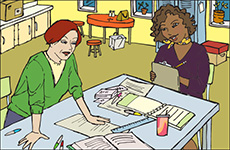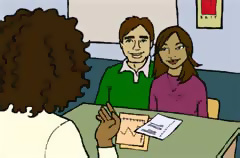What does Ms. Milton need to know about students with visual impairments?
Page 3: Consultation and Collaboration
The needs of students with visual impairments are more efficiently and effectively met when teachers, related services providers, other educational professionals, and families work together. Two useful methods of working together are consultation and collaboration.
related service providers
Professionals (e.g., orientation and mobility specialist [O&M], speech-language pathologist [SLP]) from a wide range of disciplines who work with students with disabilities to provide the supports required for the student to receive a free and appropriate public education.
Consultation
Definition: The general education teacher is the primary individual to present lessons to the students and to implement learning strategies. He or she consults regularly with other professionals and families to acquire information that facilitates the learning of students with visual disabilities.
Application: General education teachers are not expected to have the specific expertise to work with all children with disabilities without supports. Knowledgeable professionals and family members are readily available to classroom teachers to provide consultation as needed.
Collaboration
Definition: Two or more individuals work together towards a common goal of planning, implementing, or evaluating a specific aspect of an educational program for a student or group of students.
Application: General education teachers, specialists, and family members all have expertise to contribute. Instead of individuals working in isolation toward goals that may be similar or in direct conflict with one another, there is shared responsibility and accountability for a common goal.
Education Professionals
 Teachers and other education professionals may also consult and collaborate to improve student outcomes. The teacher may consult with other professionals for suggestions or information beneficial to the student’s learning. For example, Ms. Milton consults with Mrs. Edwards, the teacher of students with visual impairments (TVI), about the best way to present a math concept with which Evan is having difficulty.
Teachers and other education professionals may also consult and collaborate to improve student outcomes. The teacher may consult with other professionals for suggestions or information beneficial to the student’s learning. For example, Ms. Milton consults with Mrs. Edwards, the teacher of students with visual impairments (TVI), about the best way to present a math concept with which Evan is having difficulty.
Additionally, the teacher may collaborate with other education professionals to prepare lessons or coordinate activities that are beneficial for students with visual disabilities. For example, Ms. Milton is teaching a math lesson on measurement. She and Mrs. Edwards work together to develop a lesson plan, including hands-on activities, that presents the math concepts in a manner accessible to all students, including Evan and Emily.
The Five Step Process is a simple model to use during collaborative planning. It allows the group to identify, implement, and evaluate the success of a strategy.
| Five Step Process | |
| Step 1: | Identify the academic standard, task, and performance requirement. For social skills or strategies and behavior, identify the area of concern and the expected social skill acquisition or behavior modification. |
| Step 2: | Discuss the modifications or accommodations needed by the student. Identify the available materials and resources. |
| Step 3: | Decide which strategies, modifications, and accommodations will be used. Discuss who will be responsible for the implementation of the strategies, modifications, and accommodations |
| Step 4: | Monitor the progress of implementation using formative feedback and adapt the strategy, as needed, based on that feedback. |
| Step 5: | Evaluate the success of the implemented strategy. |
Adapted from the Five Step Process, Minnesota Department of Children, Families, and Learning, Division of Special Education (2002).
Listen as three education professionals discuss collaborating and consulting to meet the needs of students with visual impairments

Susie Dickason
Teacher of the Visually Impaired
Valley Dale Elementary School,
Azusa, CA
(time: 1:10)

Betsy Belknap
Teacher of the Visually Impaired
Longley Way Elementary School,
Azusa, CA
(time: 0:32)
Transcript: Susie Dickason
When we start the new school year, we have planning days before our students even come. And we try to meet with those teachers and discuss what the students’ needs are. We go over the IEP with them, and we explain what their vision is, what their goals are, what the overall expectations are. And we have handbooks that we give to them, and we go over the individual need of the student, like have them sitting at the front of the class. We have suggestions, like when you’re writing on the board to speak as you’re writing so that that person is getting that information auditorially, provide space for that student because––whether its large print or braille books––there’s just so much involved for them that they really need that extra space. We recommend that there’s at least two desks for them. And we just tell them, if there’s something that comes up, talk to us so that we can find a solution and just problem-solve whatever’s going on. Sometimes there’s things that we may not have thought of, and just kind of deal with things as they come to you. Open communication is crucial.
Transcript: Betsy Belknap
This is the thing that I really stress the most: Remember that they are children with visual impairments, but they are children first. And while they might need accommodations or modifications, definitely differential teaching strategies, they also need the things that every other child needs––like encouragement, structure, reasonable expectations, successful experiences, and the feeling that they’re important.
Transcript: Brandy Acker
Last year was my first year of having a visually impaired student. I was a little afraid at first, but I now enjoy it. Because of last year’s experience, I wanted the visually impaired kids this year, and it’s been a fun experience for me. Betsy Belknap is the VI teacher at our school. So whenever I have any questions, she’s usually the one that I go to. A lot of times, if I have a project that I have my regular ed. kids do that I don’t think will transfer well with the VI student, I’ll go and talk with her, maybe during lunch time, and we’ll just kind of throw ideas back and forth on what we think would work for that student.
Keep in Mind
Communication among professionals who work with students with visual impairments should be ongoing. General education teachers will need to inform professionals about times students will not be available (e.g., class fieldtrips or school assemblies). Likewise, the educational professionals will need to discuss with the general education teacher the best times to visit the classroom or to pull the students out of class for various activities (e.g., assessments or tutoring). Education professionals may want to consider several factors that enhance communication:
- Contact preference (e.g., email or phone)
- Where, when, and for how long the individual will work with the student
- Planning time availability
- Calendar of events (e.g., fieldtrips, academic units the students will study)
Parents
 To better meet the needs of students with visual disabilities, teachers and other education professionals can collaborate and consult with parents. Parents can offer a wealth of information about their child that is not available through other individuals. For example, by consulting with Mr. and Mrs. Rothman, Ms. Milton learned about Evan and Emily’s levels of independence. At the same time, teachers and parents can collaborate to discuss issues of mutual concern. For example, Ms. Milton and Mr. and Mrs. Rothman may collaborate to implement a new instructional strategy that will be used in the classroom and supported at home.
To better meet the needs of students with visual disabilities, teachers and other education professionals can collaborate and consult with parents. Parents can offer a wealth of information about their child that is not available through other individuals. For example, by consulting with Mr. and Mrs. Rothman, Ms. Milton learned about Evan and Emily’s levels of independence. At the same time, teachers and parents can collaborate to discuss issues of mutual concern. For example, Ms. Milton and Mr. and Mrs. Rothman may collaborate to implement a new instructional strategy that will be used in the classroom and supported at home.
Keep in Mind
Professionals who work with students with visual impairments and their parents should communicate regularly. Effective communication between home and school helps parents stay current on their child’s progress and informs the school about events occurring at home. They can share information in a variety of ways, such as:
- A monthly newsletter
- Parent-teacher conferences (including the TVI and O&M)
- A communication log
